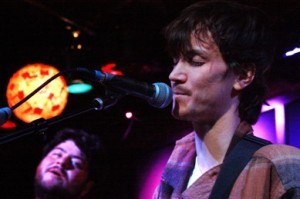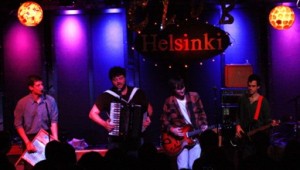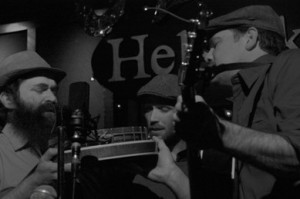CLUB HELSINKI HUDSON
Felice Brothers with Hunger Mountain Boys
Saturday, November 24, 2012
Review by Seth Rogovoy
(HUDSON, N.Y.) – It’s too bad the Felice Brothers have been hyped to the heavens as the second coming of The Band or more, because that’s an impossible comparison to live up to. It’s not fair to the group, which is better served to be described as one of the top roots-rock club bands in the Northeast – maybe even the whole U.S. (It’s hard to say which without traveling all 50 states and sampling what else is out there).
The group was perfectly adequate providing a rocking evening of entertainment before a packed house at Club Helsinki Hudson on Saturday night. The band clearly has a loyal following ranging in age from 20-somethings to those 30 and 40 years older, which speaks to both its skill and the widespread and enduring appeal of the classic values of The Band’s style of fusion of what we now call “Americana” – that blend of rock, country, folk, blues, R&B, soul, and traditional musics from the Anglo-Irish tradition.
The Felice Brothers bring to the mix an emphasis on minor key melodies; an aggressive rhythmic attack fueled by drummer Dave Turbeville, who plays like a refugee from a hardcore punk band (for better or worse, perhaps for worse in this case, as more color and subtlety might suit this kind of music better – think of Levon Helm’s style of playing, which was all about finesse and dynamics without ever being fussy); and a very contemporary anti-charisma (again, for better or worse – perhaps for worse, although this really may be a generational thing, as anti-stage presence seems to be de rigueur with the new generation of roots-rockers, as opposed to the movie-star-like presence of members of The Band, several of whom went on to become legitimate movie stars after their appearance in the farewell concert documentary The Last Waltz, directed by Martin Scorsese, movie-star-maker).
The quintet, featuring violinist Greg Farley, accordionist/keyboardist/vocalist James Felice, lead vocalist/guitarist Ian Felice, bassist/vocalist Christmas Clapton and aforementioned drummer Turbeville, is nothing if not organic, and recapitulates in many ways the feel, the vibe, if not exactly the sound or majesty, of The Band. Ordinarily “organic” is a good quality, but the Felice Brothers may carry their organic approach just a bit too far. Ian Felice has an interesting, but ultimately limited, voice – it’s a murky rasp with no brightness that easily gets lost in the mix. Clapton occasionally takes the lead vocal, and his voice lacks color even more than Ian Felice’s – think Lou Reed without the personality. James Felice actually has the best voice of the three singers but takes the fewest leads – he really shone on “Got What I Need.”
There was a moment toward the end of the show that in some ways was the high point, but merely served to underline the band’s limitations. Former bandmate but still brother Simone Felice joined the group onstage for a number, taking the lead vocal and accompanying himself on acoustic guitar. It turns out the Simone Felice has the best voice of all the brothers, and the entire vibe of the group changed with this one number – Simone boasts a manic intensity and charisma – he actually played perched upon the kick drum for a fair amount of the song (when he wasn’t down on his knees). Simone was a natural performer, and on this number, “Show Me Mercy,” the group really gelled in a way it hadn’t until then – gelled and swung.
But alas then he was gone, as was the excitement.
Berkshire-based old-time country trio the Hunger Mountain Boys warmed up the crowd for the Felice Brothers. For this show, guitarist Kip Beacco and bassist Matt Downing were joined by a terrific singer/violinist whose name I didn’t catch – not the group’s regular third member, Teddy Weber – but who was a perfect complement to the other two. The trio beautifully captures the vibe of early 20th century country swing and bluegrass roots, especially in their three-part harmonies, all singers sharing a single microphone.



